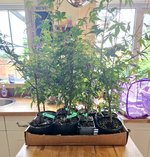So, yesterday I decided to buy myself some bonsai.
Yep, I decided to take my birthday money along to Greenwood Bonsai in Nottingham. So, on my drive to Nottingham, I decided to buy only stock for another Forest (I do like forest's) and only spend cash that I had, or I could only see myself spending all the money I have and more. So, on arrival I went around all the tree's greenwood had and by God they have plenty of trees and young saplings and tools and more. I even had the honor of meeting Corin, now me being me (a bit cheeky) asked Corin to help me chose the Japanese Maple’s for my next project, I only picked nine young saplings, But I may add some more in the autumn say October of both Maple and Larch Increase them by two for the Maple and six for the Larch I am undecided at the moment. I bought feed and two pots for my forest and two of the green compost scoops.
I am going to buy an indoor elm bonsai next week from a local bonsai nursery
So I hope you like what I have bought I do and hope the make Corin proud
Corin did say I could trim the maple now so I’m off to watch a video or three on trimming the new growth on the maple trees

Yep, I decided to take my birthday money along to Greenwood Bonsai in Nottingham. So, on my drive to Nottingham, I decided to buy only stock for another Forest (I do like forest's) and only spend cash that I had, or I could only see myself spending all the money I have and more. So, on arrival I went around all the tree's greenwood had and by God they have plenty of trees and young saplings and tools and more. I even had the honor of meeting Corin, now me being me (a bit cheeky) asked Corin to help me chose the Japanese Maple’s for my next project, I only picked nine young saplings, But I may add some more in the autumn say October of both Maple and Larch Increase them by two for the Maple and six for the Larch I am undecided at the moment. I bought feed and two pots for my forest and two of the green compost scoops.
I am going to buy an indoor elm bonsai next week from a local bonsai nursery
So I hope you like what I have bought I do and hope the make Corin proud
Corin did say I could trim the maple now so I’m off to watch a video or three on trimming the new growth on the maple trees

